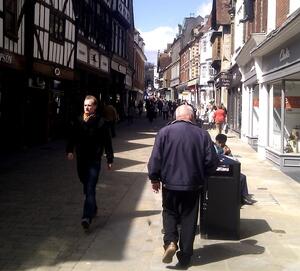At the same time there has been a growth in businesses offering services like banking or legal advice: although these may decide to locate in vacant shops they present what planners call “dead frontages” – premises that you walk past without being able to see anything inside, in contrast to the interest generated in traditional shop windows. Replacement of independent local traders with branches of national chains also detracts from a feeling that the town centre is special. More and more it seems that one town centre is pretty much like another.
Of course, there is more to a town centre than just shopping. Town centres should be a place for social activity, somewhere to meet friends, enjoy entertainment, engage with local government – and not least, to live. A town centre is likely to be a significant influence on how residents and visitors think about a place.
Branding town centres
Recently I was at an “International Design Summit” at which one speaker presented a paper that distilled his experience on using place branding to create better town centres. Malcolm Allan is a consultant. With Sicco van Gelder, he is the author of a booklet on City Branding that you can download from http://www.placebrands.net/_files/placebrands_city_branding_book.pdf. He argues that part of the problem is that we stopped viewing streets as places. Too often they are given over to traffic and ugly signage designed to manage traffic or railings that are there to prevent pedestrians moving to somewhere that they want to go. These are some of the challenges that hamper place-branding for town centres.
In his presentation, Allan explained the Locum Consulting destination development model which he uses. The key elements of the model are:
Attractors – these are things people want to see or spend time in. They are the places that accommodate shops, leisure or entertainment facilities. Heritage sites and historic areas can be attractors too.
Infrastructure – this is the “glue” that holds the attractors together, so that collectively they amount to a coherent destination. Transport facilities and other essential services including digital “piping” come into this category.
Services – cafes, bars, restaurants, hotels etc.
Markets – it is important for those managing and promoting a town centre to have an understanding of the market that they are trying to reach. Who are the centre’s services for? What is the competition offering?
Sustainability – this has two aspects. Firstly, in functional and economic terms, can the place’s “offer” be sustained over a period of time? In terms of environmental sustainability, how well is the place performing? For example is it possible to reuse existing buildings rather than knocking them down?
Management – you have to manage the way that a place works. All the destinations within that place need to be managed so that the place delivers on its promises to potential users.
Brand – when all these elements are combined, you have a destination specification from which a brand strategy can be created.
A check list to follow
Allan advocates doing an audit as a good way to understand the strengths and weaknesses of a destination. This means working through a check-list that systematically requires you to assess what the place has to offer. The list will include things like access, accommodation, attractions, entertainment, events, food and drink, physical activity, retailing and visitor services. Where a street primarily serves local residents only, then a variant of this method can be used.
The traditional main street is not an option
Allan concludes that the traditional model of the high street as a shopping parade is no longer viable. Such places need a new brand offer that cannot be trumped by out-of-town retail centres. He says “The new offer is about a combination of attractors – retail plus leisure and entertainment, gathering and performance spaces, a range of food and beverage outlets, sports and health and well-being offers and facilities, new living opportunities, new learning opportunities – mini towns as town centres.” It is important to tolerate temporary uses – even encourage them. Things like posters, exhibitions, one-off events can keep a place fresh and interesting.
Principles for branded place-making
He lists some principles for branded place-making:
Be clear about your purpose and functions;
Know what you are good at;
Understand how your market sees your purpose, function and offer;
Develop a place brand strategy with a clear vision and direction for the future;
Create a place brand partnership with key stakeholders to plan and deliver the vision;
Have active and involved brand leadership from the partnership – investment, co-operation, marketing and networking;
Sell and market your investment opportunities in a way that is consistent with the brand and builds the brand;
Act early rather than late;
Monitor, review, evaluate, re-act.
The role of design
Design has a crucial part to play. An “On-Brand” design is needed to communicate the brand and the experience of the brand. Design of buildings and spaces need to reinforce the brand. Thus, for example, if part of the brand is friendliness, then the streets need to be safe and places where people can relax and meet each other, not be shunted around so that traffic can speed past them.
It is also important that branding is not a top-down exercise. Consultation and involvement is not easy and can take time, but it also builds consensus and support in the long run.

